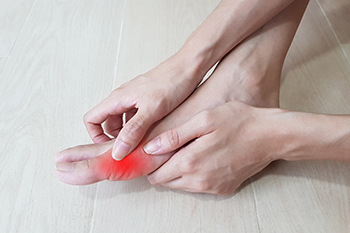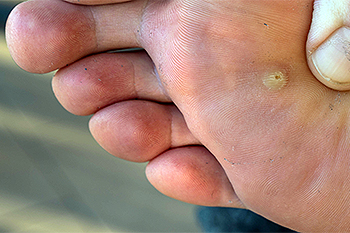Dr. Kennan T. Runte, DPM, FACFAS
Dr. Panah Nabili, DPM
Grass Valley, CA 95945
Dr. Kennan T. Runte, DPM, FACFAS
Dr. Panah Nabili, DPM

Foot stress fractures, though diminutive in size, can pack a punch when it comes to discomfort and disruption in daily activities. These fractures occur when the normal balance between bone formation and breakdown is disrupted, often due to repetitive stress or overuse. High-impact activities like running or jumping, sudden increases in physical activity, or wearing inadequate footwear can all contribute to the development of stress fractures. The bones in the foot, particularly the metatarsals, are vulnerable to micro-cracks when subjected to repetitive loading without sufficient time for recovery. Factors such as improper training techniques, changes in exercise surfaces, or underlying conditions that affect bone density can heighten the risk. If you have developed a foot stress fracture, it is suggested that you schedule an appointment with a podiatrist who can accurately diagnose and treat this condition.
Activities where too much pressure is put on the feet can cause stress fractures. To learn more, contact one of our podiatrists from Foothill Podiatry Clinic. Our doctors can provide the care you need to keep your pain free and on your feet.
Dealing with Stress Fractures of the Foot and Ankle
Stress fractures occur in the foot and ankle when muscles in these areas weaken from too much or too little use. The feet and ankles then lose support when walking or running from the impact of the ground. Since there is no protection, the bones receive the full impact of each step. Stress on the feet can cause cracks to form in the bones, thus creating stress fractures.
What Are Stress Fractures?
Stress fractures occur frequently in individuals whose daily activities cause great impact on the feet and ankles. Stress factors are most common among:
Symptoms
Pain from the fractures occur in the area of the fractures and can be constant or intermittent. It will often cause sharp or dull pain with swelling and tenderness. Engaging in any kind of activity which involves high impact will aggravate pain.
If you have any questions please feel free to contact our office located in Grass Valley, CA . We offer the newest diagnostic and treatment technologies for all your foot and ankle needs.

Gout, which is typically associated with men, can also affect women. Characterized by sudden, intense joint pain, swelling, and stiffness, this inflammatory condition primarily targets the feet and ankles in women. Symptoms of gout include redness, warmth, and limited mobility. Several factors contribute to gout in older women, including obesity, high blood pressure, and menopause, which heightens the risk. Menopausal hormonal changes disrupt uric acid balance, rendering women more susceptible to gout flares. Medication such as diuretics, commonly prescribed for high blood pressure, also may elevate uric acid levels, further affecting women. Postmenopausal women face an increased risk due to hormonal shifts. As estrogen declines during menopause, the risk of gout rises. Recognizing this connection is important for monitoring signs of gout in older women. Effective gout management in women includes implementing dietary modifications to reduce purine rich foods, in addition to weight maintenance and proper hydration. A podiatrist may prescribe certain medications that can help control uric acid levels. Gout's impact on women, particularly those who are postmenopausal, calls for some level of proactive measures. For more information about how to manage gout, it is suggested that you make an appointment with a podiatrist.
Gout is a foot condition that requires certain treatment and care. If you are seeking treatment, contact one of our podiatrists from Foothill Podiatry Clinic. Our doctors will treat your foot and ankle needs.
What Is Gout?
Gout is a type of arthritis caused by a buildup of uric acid in the bloodstream. It often develops in the foot, especially the big toe area, although it can manifest in other parts of the body as well. Gout can make walking and standing very painful and is especially common in diabetics and the obese.
People typically get gout because of a poor diet. Genetic predisposition is also a factor. The children of parents who have had gout frequently have a chance of developing it themselves.
Gout can easily be identified by redness and inflammation of the big toe and the surrounding areas of the foot. Other symptoms include extreme fatigue, joint pain, and running high fevers. Sometimes corticosteroid drugs can be prescribed to treat gout, but the best way to combat this disease is to get more exercise and eat a better diet.
If you have any questions please feel free to contact our office located in Grass Valley, CA . We offer the newest diagnostic and treatment technologies for all your foot and ankle needs.

Plantar warts, small growths caused by the human papillomavirus, or HPV, often appear on the soles of the feet. Unlike common warts, which typically grow on the hands, plantar warts can be painful due to the pressure exerted on the soles when walking or standing. These warts may have a rough, grainy appearance with tiny black dots, which are actually clotted blood vessels. Several risk factors increase the likelihood of developing plantar warts. Close contact with the virus, such as walking barefoot in damp and communal areas like locker rooms, swimming pools, or public showers, can put your feet at risk. Additionally, those with a weakened immune system, such as individuals with diabetes or HIV, are more susceptible to plantar warts. Constantly moist or sweaty feet can provide an ideal environment for the virus to thrive. If you have developed a plantar wart, it is strongly suggested that you consult a podiatrist who can provide relief with appropriate treatment methods.
Plantar warts can be very uncomfortable. If you need your feet checked, contact one of our podiatrists from Foothill Podiatry Clinic. Our doctors will assist you with all of your foot and ankle needs.
About Plantar Warts
Plantar warts are the result of HPV, or human papillomavirus, getting into open wounds on the feet. They are mostly found on the heels or balls of the feet.
While plantar warts are generally harmless, those experiencing excessive pain or those suffering from diabetes or a compromised immune system require immediate medical care. Plantar warts are easily diagnosed, usually through scraping off a bit of rough skin or by getting a biopsy.
Symptoms
Treatment
To help prevent developing plantar warts, avoid walking barefoot over abrasive surfaces that can cause cuts or wounds for HPV to get into. Avoiding direct contact with other warts, as well as not picking or rubbing existing warts, can help prevent the further spread of plantar warts. However, if you think you have developed plantar warts, speak to your podiatrist. He or she can diagnose the warts on your feet and recommend the appropriate treatment options.
If you have any questions please feel free to contact our office located in Grass Valley, CA . We offer the newest diagnostic and treatment technologies for all your foot and ankle needs.

Ankle sprains are a common and painful injury that can happen to anyone, at any time. These injuries occur when the ligaments that support the ankle are stretched or torn due to sudden or excessive twisting or rolling of the foot. The most frequent cause of an ankle sprain is a misstep, such as stepping on an uneven surface or making a sudden change in direction during physical activities. The symptoms of an ankle sprain are typically immediate and can range from mild to severe. Pain, swelling, and bruising around the affected ankle are common signs. Mobility may be restricted, and the ankle may feel unstable or weak. In more severe cases, a popping or tearing sensation may be felt at the time of injury. Understanding the causes and symptoms of ankle sprains can help individuals take the necessary precautions to protect their ankles and reduce the risk of injury. If you have endured an ankle sprain, it is suggested that you contact a podiatrist who can accurately diagnose and treat this condition.
Although ankle sprains are common, they aren’t always minor injuries. If you need your ankle injury looked at, contact one of our podiatrists from Foothill Podiatry Clinic. Our doctors can provide the care you need to keep you pain-free and on your feet.
How Does an Ankle Sprain Occur?
Ankle sprains are the result of a tear in the ligaments within the ankle. These injuries may happen when you make a rapid shifting movement while your foot is planted. A less common way to sprain your ankle is when your ankle rolls inward while your foot turns outward.
What Are the Symptoms?
Preventing a Sprain
Treatment of a Sprain
In many cases, the RICE method (Rest, Ice, Compression, and Elevate) is used to treat ankle sprains. However, you should see a podiatrist to see which treatment option would work best with your injury. In severe cases, surgery may be required.
It is important to ask your doctor about rehab options after you receive treatment for your injury. Stretching, strength training, and balance exercises may help the ankle heal while also preventing further injury.
If you have any questions, please feel free to contact our office located in Grass Valley, CA . We offer the newest diagnostic and treatment technologies for all your foot care needs.